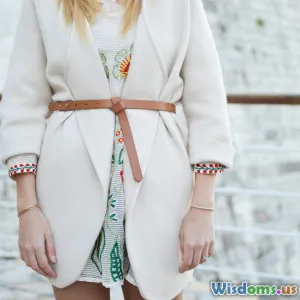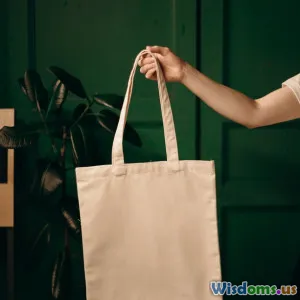
A Personal Journey to Building a Zero Waste Wardrobe on a Budget
9 min read Discover how to build a stylish zero waste wardrobe on a budget through practical tips, personal stories, and sustainable choices. (0 Reviews)
A Personal Journey to Building a Zero Waste Wardrobe on a Budget
In an era when fast fashion floods our closets with cheaply made products and mountains of textile waste choke the environment, the idea of crafting a zero waste wardrobe can feel daunting—and costly. Yet, my personal journey to building a zero waste closet has revealed that sustainability and style don’t require a lavish budget. It demands curiosity, patience, and a shift in perspective.
This article explores how I transitioned from an impulsive shopper to a mindful wardrobe curator. I’ll share practical approaches, real-world insights, and lessons that make zero waste fashion affordable and deeply rewarding.
Understanding the Zero Waste Wardrobe Concept
Before diving into tactics, it’s crucial to understand what a zero waste wardrobe truly means. Beyond the catchy phrase, it embodies a holistic approach to fashion that minimizes textile waste throughout the garment’s entire lifecycle.
What Is a Zero Waste Wardrobe?
A zero waste wardrobe is about embracing clothing that generates little to no waste — from production scraps to end-of-life landfill disposal. It includes:
- Choosing durable, timeless pieces that last decades rather than seasons.
- Prioritizing ethical brands with transparent, sustainable production methods.
- Repairing, repurposing, or donating items instead of discarding.
- Buying secondhand or upcycled garments.
- Refusing impulse purchases that contribute to fast fashion's cyclical waste.
Why Zero Waste Matters
The global textile industry is responsible for approximately 92 million tons of waste annually, with the majority ending up in landfills or incinerators. According to the Environmental Protection Agency, clothing has an average landfill lifespan of 15 years or more. Adopting a zero waste wardrobe helps reduce this environmental burden and promotes a circular economy within fashion.
Starting the Journey: Mindset Shifts and Setting Realistic Goals
My transformation began with introspection. I asked myself: "What do I really need? How can I align my wardrobe with my values without financial strain?"
From Quantity to Quality
The fast fashion cycle had ingrained a mentality where more was better. I swapped this for a philosophy valuing quality over quantity. For example, investing in three versatile, high-quality basics that can pair with various outfits proves far superior to owning dozens of poorly made items destined for landfill.
Embracing Patience and Creativity
Building a zero waste wardrobe is a marathon, not a sprint. Impulse buying had to give way to patient seeking—scouring secondhand stores, waiting for sales, or mending damaged pieces. Creativity blossomed as I learned to mix and match, or upcycle old clothes.
Practical Steps to Build a Zero Waste Wardrobe on a Budget
Here’s the actionable roadmap I followed, peppered with tips that saved money and aligned with zero waste principles.
1. Conducting a Wardrobe Audit
Start by examining what you already own. Throw away guilt, and instead document:
- Items you wear regularly.
- Garments neglected—why? Fit issues, style mismatch, damage?
- Pieces in good condition but unused.
This audit reveals gaps and stops unnecessary purchases.
2. Buying Secondhand with Purpose
Secondhand shopping became my secret weapon:
- Thrift stores: A treasure trove for timeless pieces. Found a nearly new wool coat for $15, originally retailing over $200.
- Online resale platforms: Apps like Poshmark or Depop let you filter for zero waste brands sustainably and affordably.
- Clothing swaps: Organized events allow community sharing and refreshing wardrobes for free.
Data shows with the resale apparel market projected to reach $77 billion by 2025, secondhand options are increasingly accessible and affordable.
3. Prioritizing Natural, Durable Fabrics
Synthetic fibers like polyester, despite being cheap, shed microplastics and wear out faster. I focused on:
- Organic cotton, linen, wool, and hemp—materials that biodegrade and endure.
- Checking certifications such as Global Organic Textile Standard (GOTS).
Natural fibers initially cost more but extend garment lifespan, reducing long-term spending.
4. Mending, Altering, and Repurposing
Rather than discarding, I learned to:
- Patch tears using simple sewing techniques.
- Adjust sizes with basic tailoring.
- Turn worn-out jeans into shorts or bags.
These practices extended my clothes’ life by years and drastically cut repeat expenses.
5. Adopting a Capsule Wardrobe Approach
Limiting my wardrobe to around 30 versatile pieces optimized usability and reduced clutter. For example:
- Neutral color palette that mixes effortlessly.
- Multi-functional garments like a dress that converts to a skirt.
Psychologically, this approach reinforced contentment with less.
6. Supporting Ethical Brands Thoughtfully
While many sustainable brands are pricier, selectively investing based on:
- Transparent supply chains.
- Repair or take-back programs.
- Strong sustainability commitments.
When I bought a quality certified pair of shoes, it lasted 5+ years compared to cheaper pairs replaced annually, saving money long-term and the environment.
7. Proper Garment Care
Caring well for clothes maintains appearance and durability:
- Washing in cold water to prevent fiber damage.
- Air drying instead of dryer use.
- Storing away from direct sunlight.
A study from the International Journal of Consumer Studies found simple care practices could extend clothing life by 35% or more.
Challenges Encountered and Lessons Learned
Wrestling with Fast Fashion Temptations
Despite awareness, fast fashion’s allure is strong. Overcoming it required conscious reflection, understanding the hidden costs of “cheap” clothing: environmental damage, labor exploitation, and waste.
Time Investment
Sourcing sustainable, secondhand items and mending garments demanded time. Treating this as an enjoyable, creative process helps, transforming it into a hobby rather than a chore.
Social Dynamics
Initially, friends and family questioned my thrifted or minimal wardrobe. Over time, sharing my outcomes—better style, less clutter—sparked curiosity and conversations about sustainable fashion.
Impact and Rewards Beyond the Wardrobe
Adopting a zero waste wardrobe is about personal fulfillment and ethics:
- Environmental impact: Less landfill waste, reduced carbon footprint.
- Financial savings: Avoiding frequent impulsive buys.
- Style confidence: Owning clothes that align with values builds authentic self-expression.
Moreover, this journey instilled mindful consumption habits extending beyond fashion, influencing daily choices and community engagement.
Conclusion: Your Zero Waste Wardrobe Journey Begins Now
Building a zero waste wardrobe on a budget is entirely achievable. It starts with valuing what you already own, seeking quality and versatility over quantity, embracing secondhand and sustainable fabrics, and caring deeply for your clothes.
As I’ve learned, every small choice accumulates—transforming not only your closet but also contributing meaningfully to a healthier planet. Start by auditing your closet today, exploring thrift stores, or picking up a needle and thread. Your sustainable style—and the Earth—will thank you.
Further Resources:
- Fashion Revolution: https://www.fashionrevolution.org
- ThredUp Resale Report: https://www.thredup.com/resale
- The Zero Waste Collective: https://zerowastecollective.com
Inspirational Quote:
"Buy less, choose well, make it last." – Vivienne Westwood
Embark on your sustainable wardrobe journey one thoughtful piece at a time.
Rate the Post
User Reviews
Popular Posts




















